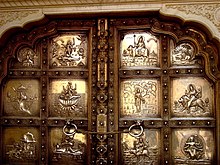
The Bangash, Bungish, Bangaš or Bangakh are a tribe of Pashtuns, inhabiting their traditional homeland, the Bangash district which stretches from Kohat to Tall in Hangu and Spīn Ghar, Kurram in Khyber Pakhtunkhwa, Pakistan. They also live as a smaller population in Dera Ismail Khel, Bannu while also a smaller population of Bangash inhabit Gardez, Paktia, Afghanistan.
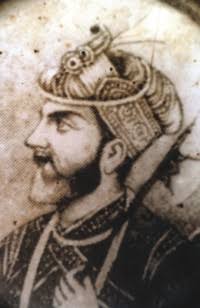
Isa Khan was the leader of the 16th-century Baro-Bhuiyan chieftains of Bengal. During his reign, he successfully unified the chieftains of Bengal and resisted the Mughal invasion of Bengal. It was only after his death that the region fell totally under Mughal control. He remains an iconic figure throughout West Bengal and Bangladesh as a symbol of his rebellious spirit and unity.
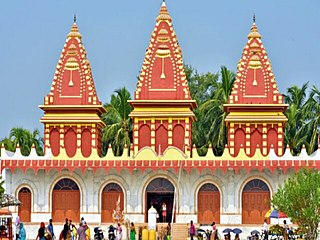
South 24 Parganas (Pron: pɔrɡɔnɔs; abbr. 24 PGS (S)), or sometimes South Twenty Four Parganas and Dakshin 24 Parganas, is a district in the Indian state of West Bengal, headquartered in Alipore. It is the largest district of West Bengal by area and second largest by population. It is the sixth most populous district in India (out of 640). On one side of the district there is the urban fringe of Kolkata, and on the other the remote riverine villages in the Sundarbans.
Sabarna Roy Choudhury was a Zamindar family of Mughal Bengal. They controlled significant swathes of territory, including what would later become Kolkata, prior to the sale of zamindari rights in 1698 to the East India Company.

Shaikh Alauddin Chisti was a Mughal general and the Subahdar of Bengal. He transferred the capital of Bengal from Rajmahal to Sonargaon and founded the city of Jahangirnagar. He was awarded the titular name of Islam Khan by Mughal emperor Jahangir.
Pratapaditya Guha was a Mughal vassal of Jessore of lower Bengal, before being crushed by the Mughal Empire. He was eulogized by 20th century Bengali nationalists as a Hindu liberator from foreign (Islamic) rule.

The Zamindars of Bengal were zamindars of the Bengal region of the Indian subcontinent. They governed an ancient system of land ownership.
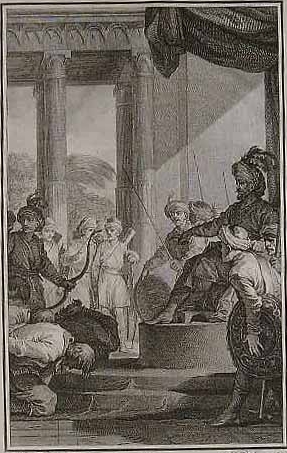
The Anglo-Mughal war, also known as the Child's war, was the first Anglo-Indian war on the Indian subcontinent.

The siege of Golconda was a siege of Golconda Fort between the Qutb Shahi dynasty and the Mughal Emperor Aurangzeb, occurring in January 1687, lasting 8 months. The fort was home of the Kollur Mine. The Golconda Fort was considered to be an impregnable fort on the Indian subcontinent. At the end of the siege, Aurangzeb and the Mughals entered Golconda victorious.
The Karrani dynasty was founded in 1564 by Taj Khan Karrani, an ethnic Afghan from the Karlani tribe, hailing from Bangash district. It was the last dynasty to rule the Sultanate of Bengal.
Mubariz Khan was the Mughal governor of Gujarat and Hyderabad Subah. He was the governor of Golconda from 1713 to 1724 until he was killed during the Battle of Shakar Kheda where he fought against Nizam-ul-Mulk, Asaf Jah I. His is known to have ruled Golconda with a free hand and brought it under stable rule from constant Maratha Raids to extract Chauth. He is generally described as a proto-dynastic figure by John F. Richards.
Khawāja Uthmān Khān Lōhānī, popularly known as Khwaja Usman, was a Pashtun chieftain and warrior based in northeastern Bengal. As one of the Baro-Bhuyans, he was a zamindar ruling over the northern parts of Bengal including Greater Mymensingh and later in South Sylhet. He was a formidable opponent to Man Singh I and the Mughal Empire, and was the last of the Afghan chieftains and rulers in Bengal. His defeat led to the surrender of all the remaining Pashtuns as well as the incorporation of the Sylhet region into the Bengal Subah. He is described as the most romantic figure in the history of Bengal. His biography can be found in the Baharistan-i-Ghaibi, Tuzk-e-Jahangiri as well as the Akbarnama.
Mubāriz Khān was a Mughal Empire commander during the reign of emperor Jahangir. He took part in many battles against the rebel Baro-Bhuiyans of Bengal. He also served as officer of Fort Jatrapur and later as the Sardar of Sylhet Sarkar.
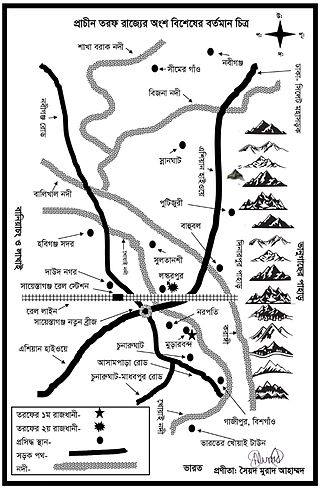
Taraf, previously known as Tungachal, was a feudal territory of the Sylhet region in Bengal and was under many petty kingdoms in different periods of time. It was part of what is present-day Habiganj District in Bangladesh.
Bayazid of Sylhet, also called Bayazid Karrani II, was a ruler in Sylhet during the early 17th century, in what is present-day Bangladesh. A prominent member of the Baro-Bhuiyan, Bayazid led military opposition against the Mughal Empire's expansion into eastern Bengal. His surrender following a sanguineous battle in 1612 ultimately resulted in their annexation of Sylhet.

Mirak Bahadur Jalair was a Mughal officer during the reign of Emperor Jahangir. He served as the chief sardar of Sylhet Sarkar from 1617 to 1620.

The Greater Jessore region predominantly includes the districts of Jessore, Jhenaidah, Narail and Magura in Bangladesh, as well as the Bangaon subdivision of India. Nestled close to the Sundarbans, the region experienced human settlement early on. It served as the capital city of the Samatata realm and passed through several Buddhist and Hindu kingdoms such as the Palas and Senas. Jessore was ruled by Khan Jahan Ali of Khalifatabad, under the Muslim Sultanate of Bengal, who is credited with establishing the Qasbah of Murali and urbanising the region through advancements in transportation and civilization. Jessore later came to be ruled by various chieftains such as Pratapaditya and became familiar to contemporary European travellers as Chandecan before being annexed to the Mughal Empire in the seventeenth century. By 1757, the British East India Company had dominated and started to establish themselves in the region. British rule lasted up until 1947, with Jessore coming under the Provisional Government of Bangladesh from 1971 onwards.

The Conquest of Bakla refers to the Mughal conquest of the Chandradwip Kingdom, which covered much of the present-day Barisal Division of Bangladesh. The campaign was led by Syed Hakim, under the orders of Islam Khan I, against Raja Ramchandra Basu.

The Conquest of Bhulua refers to the 17th-century Mughal conquest of the Bhulua Kingdom, which covered much of the present-day Noakhali region of Bangladesh. The campaign was led by Shaykh Abdul Wahid, under the orders of Islam Khan I, against Raja Ananta Manikya in 1613. The conquest of Bhulua allowed the Mughals to successfully penetrate through southeastern Bengal and conquer Chittagong and parts of Arakan.

Syed Ḥakīm was a military general of the Mughal Empire during the reign of Jahangir. He commanded the conquest of Bakla and subsequently served as the region's first Mughal faujdar.

